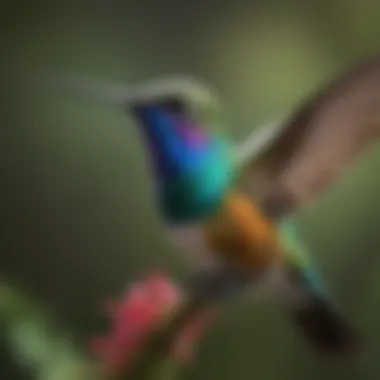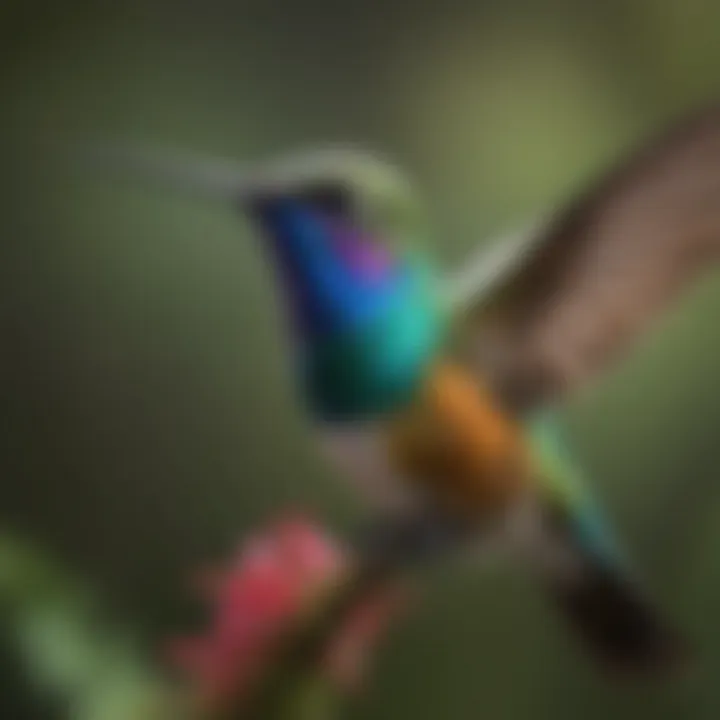The Small Hummingbird: Ecology and Woodland Significance


Intro
Small hummingbirds play an essential role in woodland ecosystems. Their ecological presence influences not just their immediate environment but also the broader interactions among various species within the forest. This article investigates the intricacies of these relationships. From unique adaptations to their feeding strategies, hummingbirds are vital for the health and diversity of the ecosystems they inhabit.
In this exploration, we will look into how these creatures contribute to biodiversity through pollination, their interactions with flora and fauna, and their increasing vulnerability due to environmental shifts. Furthermore, we will assess conservation efforts currently underway to protect their habitats. The insights gathered here are significant for forestry professionals, conservation advocates, and nature enthusiasts alike.
Understanding Woodland Ecosystems
Woodland ecosystems represent a complex web of biological interactions. They offer a diverse range of habitats for countless species, including plants, mammals, insects, and, of course, hummingbirds.
Importance of Biodiversity in Forests
Biodiversity is foundational for maintaining ecosystem stability. Here are some key points to consider:
- Species Interactions: Various species engage in complex patterns of predation and symbiosis. Hummingbirds, for instance, are crucial for pollinating plants, contributing to seed development and regeneration.
- Habitat Stability: Diverse species promote resilience against pests and diseases. A monoculture is more vulnerable than a biodiverse forest.
- Genetic Variability: More species contribute to genetic diversity, which enhances adaptability to environmental changes.
Role of Forests in Climate Regulation
Forests play a vital role in regulating local and global climates. Key functions include:
- Carbon Sequestration: Trees absorb carbon dioxide, helping to mitigate climate change effects.
- Water Cycle Regulation: Forests influence rainfall patterns and help maintain groundwater supplies.
- Temperature Moderation: Forests can help moderate temperatures, providing cooler microclimates.
Sustainable Forestry Practices
Implementing sustainable forestry practices is crucial for maintaining healthy woodland ecosystems, particularly as threats from climate change and habitat destruction escalate.
Principles of Sustainable Forestry
Sustainable forestry emphasizes:
- Ecosystem Health: Prioritizing the preservation of ecosystem functions.
- Resource Management: Using resources wisely to ensure that they naturally regenerate.
- Community Involvement: Encouraging stakeholders, including local communities, to participate in forest management activities.
Case Studies of Successful Implementations
Examples include:
- The Forest Stewardship Council: Its certification program promotes responsible forest management.
- Community Forest Projects in Oregon: Highlight successful community-driven approaches that improve forest health while providing economic benefits.
Woodland Stewardship Techniques
These techniques are central to ensuring the sustainability of woodland ecosystems.
Forest Management Plans
Creating forest management plans is a proactive approach to maintain the health and diversity of forests. These plans typically include:
- Assessment of Current Forest Conditions
- Setting Management Objectives
- Monitoring and Adaptive Management
Conservation Strategies
Conservation strategies can mitigate the impact of human activities on woodland ecosystems. Key approaches involve:
- Restoration of Degraded Areas: Reintroducing native plants and removing invasive species.
- Habitat Corridors: Ensuring connectivity between fragmented habitats to support species movement.
"Conserving hummingbird habitats is not just about protecting the birds but maintaining the delicate balance of our ecosystems."
This synthesis offers a framework for understanding the importance of these small creatures and emphasizes the need for continued research and action.
The Biology of Small Hummingbirds
Understanding the biology of small hummingbirds is crucial for comprehending their ecological role and how they interact with woodland ecosystems. Small hummingbirds serve as a vital component in many natural environments. Their unique attributes enable them to thrive in diverse habitats. Their intricate biology not only affects their survival but also influences plant life and insect populations, showcasing their significance in ecological balance.
Physical Characteristics
Small hummingbirds exhibit unique physical traits that enable them to adapt effectively to their surroundings.
- Size: They are among the smallest birds, typically ranging from 3 to 5 inches in length. Their diminutive size allows them to access nectar from various flowers that larger birds cannot.
- Coloration: Many species display vibrant plumage. This colorful appearance is not just for show; it plays a role in mating rituals and attracting potential partners.
- Wings: Their wings can beat up to 80 times per second, allowing for agile flight patterns and the ability to hover in one spot. This ability to hover enables them to feed efficiently on nectar.
- Beak Structure: The shape and length of their beaks vary depending on nectar sources. Long, slender beaks are suited for deep flowers, while shorter beaks assist in accessing nectar from various plants.
Unique Adaptations
Small hummingbirds possess several adaptations that set them apart in the avian world. One of the most notable adaptations is their metabolism. They have the highest metabolism of any bird species, requiring frequent feeding to sustain their energy levels. A single bird can consume nectar equivalent to double its body weight daily.
- Aerodynamic Flight: Their wing structure allows for unique flight capabilities, including flying backward. This ability aids in navigating complex floral environments with ease.
- Thermoregulation: To conserve energy, they can enter a state of torpor at night. This physiological adjustment allows their body temperature to drop significantly, minimizing energy expenditure.
- Vision: Their vision is superior, enabling them to detect ultraviolet light. This ability helps them locate blooms and identify ripe fruits more effectively.
Species Diversity
The diversity among small hummingbirds is remarkable, with over 330 species identified globally. They can be found throughout the Americas, with species thriving in habitats ranging from tropical rainforests to temperate woodlands. Understanding this diversity is important for several reasons:
- Ecological Specialization: Each species often specializes in specific plants for feeding, demonstrating interdependence within ecosystems.
- Evolutionary Adaptations: The variations in size, coloration, and feeding behavior reflect adaptation to environmental changes over time.
- Conservation Awareness: Knowledge of species diversity can guide conservation efforts, highlighting which species are vulnerable or endangered due to habitat loss or climate change.
"Small hummingbirds exemplify a delicate balance within woodland ecosystems, showcasing both the fragility and resilience of specialized species."
In summary, the biology of small hummingbirds is multifaceted and integral to their ecological roles. Their unique adaptations, physical features, and species diversity contribute significantly to the functioning of woodland ecosystems.
Feeding Habits and Nutritional Needs


The feeding habits and nutritional requirements of small hummingbirds are central to their survival and ecological roles in woodland ecosystems. Understanding these behaviors helps to appreciate their contributions to biodiversity and their interactions with the environment. Hummingbirds require a balanced diet that primarily consists of nectar and insects. The nutritional aspects of their feeding behaviors have far-reaching implications for both the species and their habitats.
Nectar Feeding
Nectar serves as the primary food source for small hummingbirds. These birds are especially adapted to feed on sugary fluids from flowers. Their long, slender bills and specialized tongues allow them to extract nectar efficiently.
When visiting flowers, hummingbirds play a vital role in the process of pollination. As they move from plant to plant, they inadvertently transfer pollen, which is essential for plant reproduction.
The quality and availability of nectar can vary based on several factors:
- Flower Species: Different flowers have varying nectar compositions, offering distinct sugar concentrations and amino acids.
- Seasonal Changes: Flowering times affect nectar availability. Some species bloom at specific times of the year, aligning with hummingbird migration patterns.
- Climate Influence: Weather conditions also impact flowering, resulting in variations in nectar availability.
Nectar feeding enables hummingbirds to fulfill their high energy requirements, critical for their fast metabolism, particularly during flight.
Insect Consumption
Although nectar is vital, hummingbirds also rely on insects as a protein source. Small insects provide essential amino acids and minerals that nectar alone does not supply. Common insects consumed by hummingbirds include:
- Gnats
- Spider mites
- Aphids
The hunting strategy of hummingbirds often involves hovering and darting to catch insects in mid-air. This agile hunting is critical for maintaining their energy balance. Moreover, during nesting seasons, parental birds rely on insect protein to feed their chicks, illustrating the intertwining of nectar and insect consumption in their life cycle.
Role in Pollination
Hummingbirds are instrumental in the pollination of many plant species. As they move from flower to flower, they not only consume nectar but also facilitate the transfer of pollen. This symbiotic relationship is critical for the reproductive success of numerous plants, especially those in woodland environments.
The characteristics of hummingbirds that aid in pollination include:
- Fusiform Body Shape: Their streamlined bodies allow them to maneuver easily among flowers.
- Color Vision: Hummingbirds are attracted to brightly colored flowers, particularly red and orange hues.
- Feeding Behavior: Their tendency to favor specific flower shapes optimizes the pollination process, ensuring that pollen is effectively transferred from one bloom to another.
In summary, the feeding habits and nutritional needs of small hummingbirds are complex and vital for their role in ecosystems. Nectar provides immediate energy, while insect consumption fulfills nutritional gaps. Their contribution to pollination extends beyond their own survival and influences the health and diversity of woodland ecosystems.
Habitat and Distribution
The habitat and distribution of small hummingbirds warrant significant consideration as they play a crucial role in the overall health and functioning of woodland ecosystems. These birds are not just solitary inhabitants; their presence is tied to various environmental factors that influence both their survival and the ecological balance. Understanding where these birds thrive helps us appreciate their contributions to biodiversity and forest vitality.
Natural Habitats
Small hummingbirds typically inhabit diverse environments, including temperate woodlands, forests, and shrublands. Their nesting sites often reside in areas rich in flowering plants which provide essential food sources, primarily nectar. Dense foliage is also critical for their nesting, offering shelter from predators and harsh weather. The composition of trees and plants within these habitats directly influences the availability of resources for the birds.
In the Eastern United States, the Ruby-throated Hummingbird prefers deciduous forests. Here, they can find the necessary food sources and suitable nesting sites. On the other hand, in regions such as the West Coast, species like the Anna's Hummingbird are more common in urban gardens and coastal shrublands. This adaptability reflects the importance of local flora in sustaining hummingbirds, which often relies on specific plants to fulfill their dietary needs.
Migratory Patterns
Migration is a salient feature in the lives of many small hummingbird species, particularly for those in North America. They exhibit remarkable long-distance travel, often journeying thousands of miles between their breeding and wintering grounds. For instance, the Rufous Hummingbird migrates from its breeding territories in Western Canada to winter in Mexico.
This migratory pattern is driven by changes in food availability and climate. During spring, birds return to north to take advantage of blooming flowers, ensuring a steady nectar supply. Research indicates that this migration is also linked to environmental cues, such as temperature and daylight length. Understanding these patterns is vital for conservation efforts, especially given the impacts of climate change.
Impact of Urbanization
Urbanization significantly influences the distribution of small hummingbirds. As cities expand, their natural habitats are often altered or lost. This has multifaceted impacts on hummingbird populations, affecting both their feeding and nesting behaviors.
In urban settings, hummingbirds may rely on introduced species of plants, often cultivated in gardens, parks, and landscaped areas. While these plants can sometimes provide adequate food, the lack of native flora may limit their options and reduce biodiversity.
Moreover, fragmentation of habitats due to urban development can create isolated pockets of suitable environments, hindering migration and leading to a drop in genetic diversity.
Conscientious urban planning and habitat restoration projects can mitigate these effects, helping maintain hummingbird populations in proximity to urban areas.
The preservation of native plants in urban landscapes is essential for sustaining hummingbird populations.
In summary, understanding the habitat and distribution of small hummingbirds allows for the identification of strategies that can enhance their survival in a rapidly changing world. Conservation efforts must prioritize the protection and restoration of natural habitats while considering the effects of urban development.
Behavioral Attributes
In examining the small hummingbird, the importance of their behavioral attributes cannot be overstated. Their behaviors play a critical role in their interactions with the environment and influence their survival and reproductive success. Understanding these attributes helps us appreciate their role in woodland ecosystems.
Territorialism
Territorialism in small hummingbirds manifests primarily during the breeding season. Male hummingbirds often establish and defend feeding territories rich in nectar sources. This behavior ensures that they have exclusive access to vital food resources to attract mates. The defending of territories involves aggressive displays, vocalizations, and sometimes even physical confrontations with rival males. This behavior is not without its benefits. By safeguarding a territory, hummingbirds can increase their chances of attracting potential mates, as females often prefer males with the best territories. Moreover, effective territorial defense enhances their overall fitness by ensuring a consistent food supply.
Mating Rituals
Mating rituals are another fascinating aspect of small hummingbird behavior. During courtship, males perform elaborate aerial displays to showcase their agility and vibrant plumage. These displays often include intricate flight patterns and vocalizations designed to capture the attention of females. The quality of the male’s performance can significantly influence female mate choice. Research suggests that females may select mates based not only on physical attributes but also on the complexity and intensity of their displays. This selective pressure plays a crucial role in maintaining genetic diversity within populations. Mating rituals are essential not only for reproduction but also for reinforcing the social structure within hummingbird communities.
Communication Techniques
Communication among small hummingbirds is multifaceted, involving both vocalizations and physical signals. These birds communicate through a range of chirps and calls, which convey information about territory, alarm signals, and mating readiness. Additionally, body language plays a significant role. For instance, the positioning of their feathers can indicate their mood or status. The interplay of vocal and visual communication forms a complex language that is essential for maintaining social hierarchies, avoiding conflicts, and facilitating mating. Understanding these communication techniques offers insights into their daily lives and highlights their adaptability within diverse environments.
"The behavioral attributes of small hummingbirds significantly contribute to their ecological roles, providing insights into their survival strategies and interactions within woodland ecosystems."
In summary, the behavioral attributes of small hummingbirds reveal important ecologies at play in woodland settings. Their territorialism ensures successful reproduction, while mating rituals foster genetic diversity. Additionally, effective communication aids in social interactions, thereby emphasizing their indispensable role in the ecosystem.
Ecosystem Contributions
The contributions of small hummingbirds to woodland ecosystems are significant and multifaceted. Their presence influences various ecological processes that enhance biodiversity and stabilize ecosystems. The article highlights several key contributions that demonstrate why these birds are vital to their environment.


Biodiversity Enhancement
Small hummingbirds play a crucial role in enhancing biodiversity in woodland ecosystems. Their foraging habits lead to increased interaction with various plant species. As they visit flowers to collect nectar, they facilitate cross-pollination, which promotes genetic diversity in plants. This genetic variability not only helps plant populations adapt to changing environmental conditions but also supports the overall health of the ecosystem.
Additionally, hummingbirds are often attracted to specific flora, such as various wildflowers and shrubs. These interactions can help in establishing and maintaining diverse plant communities, which, in turn, supports a wider range of animal species. A rich plant diversity also creates various habitats for insects and other wildlife, enhancing the complexity of the ecosystem.
Plant Reproductive Success
The role of hummingbirds in plant reproductive processes cannot be overstated. By transferring pollen from one flower to another, they increase the reproductive success of many flowering plants. Research indicates that many species rely heavily on hummingbirds for effective pollination. For instance, plants like the trumpet vine and many salvia species have evolved to attract these birds through specific colors, shapes, and scents of their flowers. The specialization helps to ensure that pollen is efficiently delivered, leading to successful fertilization and seed development.
Moreover, this plant reproduction is not just beneficial for the plant species themselves but also for the entire food web, as it supports the growth of fruits, seeds, and other resources that various animal species depend on. The continuous cycle of pollination and reproduction helps maintain the health of woodland ecosystems.
Seed Dispersal Mechanisms
While hummingbirds are primarily known for their role in pollination, they also contribute to seed dispersal, although indirectly. As these birds consume nectar and occasionally consume small insects, they inadvertently transport seeds that might stick to their feathers or be ingested and excreted. When they visit different flowers and habitats, they contribute to the distribution of plant species across various locations.
This seed dispersal is vital for plant species that may rely on these birds to expand their range and colonize new habitats. It helps maintain genetic diversity within plant populations and can lead to the establishment of new plant communities in various areas. Overall, the mechanisms by which small hummingbirds influence seed dispersal are an essential factor in the stability and resilience of woodland ecosystems.
"Hummingbirds serve as key players in the intricate web of woodland ecosystems, fostering biodiversity, and facilitating plant reproduction."
In summary, small hummingbirds significantly enhance woodland ecosystems through biodiversity enhancement, promotion of plant reproductive success, and seed dispersal mechanisms. Their contributions help maintain the health and resilience of these ecosystems, showcasing the importance of their conservation.
Hummingbirds and Forest Health
Small hummingbirds play a crucial role in maintaining the health of woodland ecosystems. Their activities are linked to the overall well-being of various plant and insect populations. Understanding how these birds impact forest health is important for conservation efforts and biodiversity initiatives in these regions.
Indicators of Ecosystem Health
Hummingbirds serve as bioindicators of forest ecosystem health. Their presence often points to a balanced ecosystem, as they rely on a diverse set of flowering plants for nectar. When small hummingbird populations decline, it can signal broader issues such as habitat degradation or changes in local biodiversity. Monitoring these birds can therefore provide insights into the overall condition of their habitats.
Research has shown that healthy hummingbird populations correlate with abundant floral resources and high insect diversity. Observing shifts in their feeding patterns can also reveal information about the health of local flora and fauna. When changes occur, such as a reduction in nectar availability, it often highlights underlying ecological challenges that need addressing.
Impact on Insect Populations
The presence of small hummingbirds influences insect populations significantly. These birds consume a variety of small insects as part of their diet, particularly during breeding season when energy demands are higher. This control helps maintain insect populations in check, preventing overpopulation of certain species that could harm plant health.
Furthermore, hummingbirds help facilitate dynamic interactions within the insect community, encouraging a more diverse and stable environment. Predation by hummingbirds can curb the growth of pest species, promoting ecological balance. Their feeding methods also indirectly support insect diversity, as the foliage needs to maintain a rich supply of nectar-producing flowers attracts various beneficial insects.
Influence on Plant Communities
Small hummingbirds significantly influence the dynamics of plant communities, particularly in woodland ecosystems. They act as vital pollinators, which enhances plant reproductive success. By transferring pollen from one flower to another, they contribute to genetic diversity among plants, leading to healthier and more resilient plant populations.
Certain plants have evolved traits specifically to attract hummingbirds. Flowers that are brightly colored and tubular in shape are common targets, as they match the birds' feeding adaptations. When hummingbirds feed, they not only get the sugar-rich nectar but also assist plants in their reproduction. This symbiotic relationship fosters the growth of diverse plant life, creating complex habitats for other organisms.
"The interactions between hummingbirds and plants are a testament to co-evolution, where both parties benefit and thrive in a mutually supportive relationship."
Effective conservation strategies must consider these interrelations. Protecting hummingbird habitats directly supports the integrity of plant communities and, consequently, the broader forest ecosystem.
Threats to Small Hummingbirds
Understanding the threats to small hummingbirds is crucial for both ecological integrity and conservation efforts. These birds not only symbolize the beauty of nature, but also play significant roles in their ecosystems. Their decline due to various threats can have ripple effects across the woodland environments they inhabit, impacting many other species and the overall health of these systems.
Climate Change
Climate change is a predominant threat to small hummingbirds. Rising temperatures and changing weather patterns alter their habitats and food sources. For instance, shifts in flowering times of plants can lead to mismatches between the availability of nectar and the hummingbirds' migratory schedules. Some species may struggle to adapt to these rapid changes, leading to population declines. According to various studies, several species of hummingbirds are moving to higher elevations or latitudes in search of more suitable climates. This shift can result in habitat loss if suitable environments become scarce.
Habitat Loss
Habitat loss presents another significant challenge for small hummingbirds. Deforestation, urbanization, and agriculture are major contributors to the fragmentation and degradation of their natural habitats. As woodlands are cleared for development or agricultural expansion, the spaces available for these birds to feed and reproduce diminish. This loss of habitat can lead to decreased food sources and increased competition among hummingbirds. Local populations may not be able to sustain themselves, leading to further declines.
Pesticide Exposure
Pesticide exposure poses a serious risk to small hummingbirds, affecting their health and reproductive success. The chemicals used in agriculture can bioaccumulate in insect populations, which are a critical food source for these birds. As small hummingbirds consume contaminated insects, they face significant health risks. Chronic exposure to pesticides can lead to reduced reproductive rates and increased mortality. Furthermore, pesticide runoff can impact the surrounding flora, diminishing the availability of nectar-producing flowers that are vital for their survival.
Small hummingbirds are crucial for the pollination of many plants, hence their threats might not only affect their survival but also the whole ecosystem.
Overall, these threats highlight the need for immediate action and targeted conservation strategies. It is essential to address climate change, protect habitats, and regulate pesticide use to ensure the survival of small hummingbirds and the vitality of the ecosystems they support.
Conservation Efforts
Conservation efforts play a crucial role in sustaining small hummingbird populations and their habitats. These initiatives address various threats faced by these birds, such as habitat loss and climate change. Protecting hummingbirds is not only about the birds themselves but also about maintaining the ecological balance within woodland ecosystems where they thrive.
Protected Areas and Reserves
Protected areas and reserves are vital for the conservation of small hummingbirds. These regions provide safe habitats free from urban development and agricultural pressures. National parks and wildlife reserves protect not only hummingbirds but also the diverse flora and fauna that make up their ecosystem. In these areas, the management practices typically prioritize native plant species that are essential for hummingbird feeding and nesting.
The establishment of protected areas allows for the maintenance of critical migration routes as well. For instance, migratory species use specific flyways during seasonal changes. Keeping these routes undisturbed is essential for their survival.
Restoration Projects
Restoration projects aim to rehabilitate damaged ecosystems that support hummingbird populations. Many projects focus on reforesting areas that have been deforested or degraded. Restoring native plants can enhance the availability of nectar. It is important to plant a variety of species to cater to different hummingbird preferences.
In addition, restoring wetlands can also be beneficial, as these areas often serve as vital feeding and breeding grounds. Hummingbirds rely on balanced ecosystems. Active efforts to restore these environments can make a measurable difference in their populations.
Community Initiatives


Community initiatives focus on local engagement in conservation efforts. Grassroots movements help raise awareness about the importance of protecting hummingbirds and their habitats. Workshops, educational programs, and local conservation projects can foster appreciation for these birds.
Community members can take part in plant native gardens that attract hummingbirds. Schools can initiate educational programs that emphasize the role of hummingbirds in ecosystems. Local conservationists can benefit from collaboration with schools and community organizations. Public interest generates support for policies that protect environments crucial to hummingbirds’ survival.
Investing in community-led conservation and education can significantly benefit small hummingbirds and their ecosystems.
By integrating these conservation efforts, we can ensure that the ecological significance of small hummingbirds continues to be recognized and valued in woodland ecosystems. Their presence is integral not just to the natural world, but also to the rich tapestry of life that it supports.
The Cultural Significance of Hummingbirds
Hummingbirds hold a unique and profound role in the cultures and traditions of various communities around the world. Their elusive nature, remarkable agility, and vibrant colors have inspired countless stories, myths, and artistic expressions. Understanding their cultural significance expands our appreciation of these small creatures beyond their ecological roles. This section will explore the impact of hummingbirds in indigenous cultures, their symbolism in art and literature, and their relevance in educational contexts.
In Indigenous Cultures
In many indigenous cultures, hummingbirds are revered for their beauty and agility. They symbolize love, joy, and the importance of living in the moment. For instance, the Native American tribes of the Southwest consider the hummingbird as a messenger that brings good fortune. They sometimes integrate hummingbird feathers into their regalia and rituals, believing that these birds attract positive energy.
Many myths and legends surround these birds. In some South American cultures, it is told that the hummingbird brings the sun's light to the Earth. This reinforces their status as symbols of light and vitality. Additionally, they are thought to be the spirits of ancestors or departed loved ones watching over the community. Such beliefs underscore the significance of hummingbirds in cultural traditions, creating a deep bond between nature and spirituality.
Symbolism in Art and Literature
Hummingbirds are frequently depicted in various artistic forms, from paintings to sculptures and textiles. Their vibrant colors and rapid movements provide an attractive subject for artists seeking to convey themes of beauty and transience. In literature, these birds often represent concepts such as resilience and hope. The agility of the hummingbird serves as a metaphor for overcoming obstacles, reflecting the duality of fragility and strength.
Works of art that feature hummingbirds often celebrate nature's wonders. They remind viewers of the delicate balance within ecosystems. For example, Western artists like Georgia O'Keeffe have famously illustrated these birds, capturing their essence in a manner that speaks to both nature appreciation and the intricate connections within it. Writers, too, use hummingbirds to convey poignant messages of life's fleeting pleasures, exploring how moments of beauty can inspire and uplift individuals.
Educational Relevance
Hummingbirds offer a rich topic for educational discussions, particularly in biology, ecology, and cultural studies. Their unique adaptations and roles in ecosystems serve as effective teaching tools. Students learn about pollination, biodiversity, and the interconnectedness of species through the lens of hummingbird behavior and ecology. Focusing lessons on these birds can foster an understanding of broader environmental issues.
Moreover, incorporating cultural perspectives into science education promotes a holistic view of nature. Teaching students about the symbolic significance of hummingbirds in various cultures allows for a deeper appreciation of both biodiversity and cultural diversity. This not only enriches the curriculum, but also encourages critical thinking about how human beliefs intertwine with environmental stewardship.
"Hummingbirds exemplify the intricate relationship between nature and culture, illustrating how ecology and humanity can coexist in meaningful ways."
In summary, the cultural significance of hummingbirds extends far beyond their ecological roles. Their presence in indigenous cultures, art, literature, and education highlights their multifaceted impact on human societies. Recognizing this significance encourages a more profound respect for these tiny yet powerful creatures.
Citizen Science and Hummingbird Monitoring
Citizen science plays a fundamental role in the study and conservation of small hummingbirds in woodland ecosystems. With the advent of technology, regular individuals can participate in scientific research, contributing valuable data and insights. This grassroots involvement is not only beneficial for hummingbird monitoring but also fosters a deeper connection between people and wildlife, enhancing community engagement in environmental conservation.
Engagement Opportunities
There are multiple avenues for citizens to engage in hummingbird monitoring. Various organizations, such as the Cornell Lab of Ornithology and the North American Species Initiative, offer programs that allow individuals to submit their observations. These programs often include training workshops, which equip participants with the necessary skills to identify different hummingbird species and their behaviors. Some specific activities include:
- Field Observations: Participants can record hummingbird sightings in their local areas or during migration seasons.
- Nectar Feeders Monitoring: By setting up feeders, enthusiasts can track the frequency of visits by hummingbirds and document which species are present.
- Participatory Research Projects: Collaborating in initiatives that focus on habitat restoration or the impact of climate change on hummingbirds.
These engagement opportunities not only help researchers gather critical data but also create a sense of purpose for the participants.
Data Collection Methodologies
Effective data collection is vital to understanding small hummingbirds' behaviors, demographics, and ecological roles. Citizen scientists often use standardized methodologies to ensure the reliability of the data. Key components include:
- Consistent Reporting Forms: Participants are encouraged to use designated forms to report their observations consistently. This includes date, location, species identification, and the behavior exhibited.
- Photography: Documenting sightings through photographs can aid in verifying species identification and assessing population trends.
- Monitoring Protocols: Utilizing established protocols for feeder usage, such as maintaining a consistent nectar solution ratio, observing feeding frequency, and recording interaction with other species.
These methodologies contribute to a comprehensive understanding of hummingbird ecology and help build a robust database for ongoing research initiatives.
Contributions to Research
Citizen science initiatives significantly enhance research efforts concerning small hummingbirds. The contributions made by everyday individuals comprise:
- Large Data Sets: The volume of data collected across various locations allows researchers to analyze trends over larger scales than typical academic studies.
- Citizen Insights: Observations may reveal unexpected patterns in behavior, migration routes, or feeding habits that help guide future research focus.
- Awareness and Advocacy: Participants often become vocal advocates for hummingbird conservation, disseminating knowledge within their communities and influencing local policies.
The involvement of citizens in scientific research not only aids in the preservation of small hummingbirds but also encourages a broader appreciation for biodiversity within woodland ecosystems.
Conclusion: Citizen science initiatives empower individuals to participate actively in conservation efforts, leading to beneficial outcomes for both hummingbirds and the environment.
Future Perspectives on Hummingbird Conservation
Hummingbird conservation is critical for maintaining biodiversity in woodland ecosystems. As key pollinators, small hummingbirds contribute significantly to plant reproduction and, consequently, the overall health of their habitats. This section explores the future perspectives of hummingbird conservation by considering innovative preservation strategies, the role of technology in conservation efforts, and the importance of global collaboration.
Innovative Preservation Strategies
Effective preservation strategies must adapt to the changing environmental conditions affecting small hummingbirds. These strategies can include:
- Habitat Restoration: Rehabilitating degraded forests to support native flora that hummingbirds rely on. This can involve replanting native plants, controlling invasive species, and ensuring water sources are clean and accessible.
- Creation of Pollinator Gardens: Planting gardens that focus on nectar-rich flowers can provide food sources while also promoting community awareness.
- Sustainable Land Management: Implementing practices that minimize habitat destruction and fragmentation, ensuring that hummingbirds have sustainable environments to thrive in.
These strategies help ensure the survival of hummingbirds and their ecosystems. They need to be backed by funding and public awareness.
Role of Technology in Conservation
Technology offers promising avenues for enhancing conservation efforts for small hummingbirds. Some applications include:
- Remote Sensing and GIS: These tools allow researchers to monitor changes in habitats and identify critical areas for conservation. By utilizing satellite imagery, conservationists can track deforestation or habitat loss in real-time.
- Citizen Science Apps: Platforms like eBird encourage the public to report bird sightings, creating valuable data for scientists. This data helps track populations and migration patterns.
- Environmental Monitoring Devices: Sensors can monitor temperature, humidity, and even the presence of pollutants. These devices provide data to understand how environmental changes impact hummingbirds.
Incorporating technology will streamline conservation efforts and empower researchers and enthusiasts.
Global Collaboration Efforts
Hummingbird conservation is not solely a local or national responsibility; it demands global collaboration. The international aspect of conservation emphasizes:
- Transboundary Conservation Projects: Many hummingbird species migrate across borders. Cooperation among countries can improve conservation outcomes through shared resources and information.
- International Policy Frameworks: Adopting agreements like the Convention on Biological Diversity can unify global text and strengthen conservation actions.
- Global Education Campaigns: Raising awareness through international campaigns can educate people on the importance of hummingbirds. Collaborating with NGOs and educational institutions is crucial.
"The future of hummingbird conservation will rely heavily on our ability to unite efforts across borders and disciplines."
The intersection of conservation strategies, technology, and global cooperation presents a pathway for preserving small hummingbirds in woodland ecosystems. This comprehensive perspective is not only vital for their future but also for the broader ecological health of the environments they inhabit.







